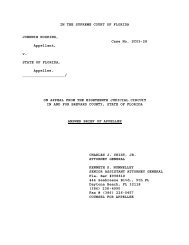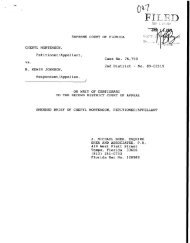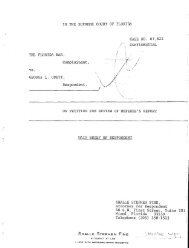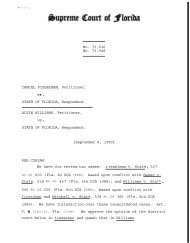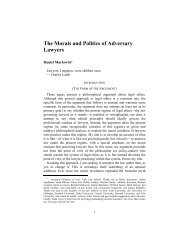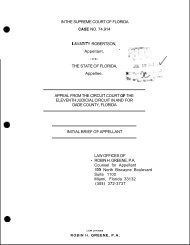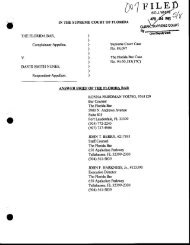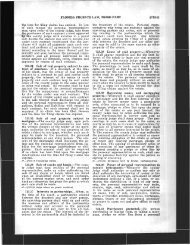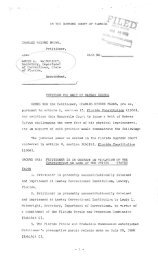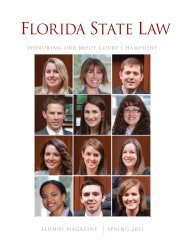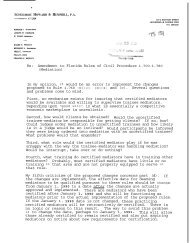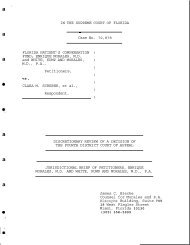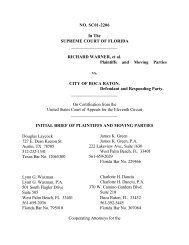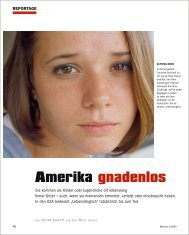ethics and professionalism in non- adversarial lawyering
ethics and professionalism in non- adversarial lawyering
ethics and professionalism in non- adversarial lawyering
Create successful ePaper yourself
Turn your PDF publications into a flip-book with our unique Google optimized e-Paper software.
1999] NON-ADVERSARIAL LAWYERING 165<br />
toward the lawyer who will use the rules <strong>in</strong> the most technocratic way 68<br />
to avoid them <strong>and</strong> seek self-<strong>in</strong>terest wherever possible?<br />
I leave you with two different formulations, which I have worked on<br />
over the past few years. First is an aspirational code express<strong>in</strong>g the ten<br />
most important responsibilities that I th<strong>in</strong>k lawyers should undertake<br />
when act<strong>in</strong>g <strong>in</strong> these new capacities. Second, appended to this essay is a<br />
detailed <strong>and</strong> complex ethical rule, currently under submission to the<br />
ABA’s Ethics Commission 2000 on the possible revision of the Model<br />
Rules of Professional Conduct <strong>and</strong> to the many states enact<strong>in</strong>g ethical<br />
rules for third party neutrals. 69 I welcome comments <strong>and</strong> reactions to<br />
these formulations. What I most wish to express, however, is that although<br />
the ethical issues are difficult <strong>and</strong> the analogies to the lawyer’s<br />
role as adversary or advocate will not take us very far to resolve these<br />
problems, I do not want the complexity of the ethical issues to prevent<br />
lawyers from engag<strong>in</strong>g <strong>in</strong> these new roles; they are difficult <strong>and</strong> unfamiliar<br />
to those with conventional legal educations. 70 These new roles are<br />
our future—<strong>in</strong> our ability to f<strong>in</strong>d new ways to solve problems <strong>and</strong> meet<br />
human needs—<strong>and</strong> these, it seems to me, are appropriate goals for our<br />
profession <strong>and</strong> our human <strong>ethics</strong>.<br />
II. THE TEN COMMANDMENTS OF APPROPRIATE DISPUTE RESOLUTION: AN<br />
ASPIRATIONAL CODE 71<br />
1. Lawyers should have an obligation to consider <strong>and</strong> <strong>in</strong>form the<br />
client about the possible methods of resolv<strong>in</strong>g a dispute, plann<strong>in</strong>g a<br />
transaction, or participat<strong>in</strong>g <strong>in</strong> legislative, adm<strong>in</strong>istrative or other processes<br />
that might best address the client’s needs. Lawyers should educate<br />
themselves <strong>and</strong> their clients about all available options for h<strong>and</strong>l<strong>in</strong>g the<br />
client’s matter.<br />
2. Lawyers should promptly communicate all proposals to resolve<br />
disputes by any process suggested by other parties, clients or decision-makers.<br />
3. Lawyers should consider <strong>and</strong> promptly communicate all substantive<br />
proposals for dispute resolution or transactional agreements to<br />
their clients, <strong>in</strong>clud<strong>in</strong>g both legally based remedies <strong>and</strong> resolutions <strong>and</strong><br />
68. See Heidi Li Feldman, Codes <strong>and</strong> Virtues: Can Good Lawyers Be Good Ethical Deliberators?,<br />
69 S. CAL. L. R EV. 885, 885 (1996) (contrast<strong>in</strong>g “technocratic” rule manipulation of<br />
<strong>ethics</strong> rules with more discretionary <strong>and</strong> “sentimentally relevant ethical deliberation).<br />
69. This proposed Rule applies to lawyers act<strong>in</strong>g as third party neutrals only—not to others<br />
who may also engage <strong>in</strong> these activities.<br />
70. Currently, several projects are underway to attempt to <strong>in</strong>troduce more conflict resolution<br />
<strong>and</strong> problem solv<strong>in</strong>g <strong>in</strong> legal education <strong>in</strong>clud<strong>in</strong>g the CPR Commission on Legal Education<br />
<strong>and</strong> Problem Solv<strong>in</strong>g, funded by the Open Society Institute; the Missouri-Columbia curriculum<br />
<strong>in</strong>tegration <strong>and</strong> dissem<strong>in</strong>ation project, funded by FIPSE; <strong>and</strong> an <strong>in</strong>terdiscipl<strong>in</strong>ary sem<strong>in</strong>ar on<br />
conflict resolution <strong>in</strong> the law school curriculum at Stanford, funded by the Hewlett Foundation.<br />
As with all attempts to change legal education, only outside fund<strong>in</strong>g seems to motivate legal<br />
educators to look at new subject matter <strong>and</strong> new pedagogy, but that is a subject for another day!<br />
71. These aspirational st<strong>and</strong>ards were developed through my work with the ABA Section<br />
on Dispute Resolution, Ethics Sub-Committee; the Committee has not endorsed these or any<br />
other formal formulations of <strong>ethics</strong> rules for the <strong>non</strong>-<strong>adversarial</strong> lawyer. The full section of Dispute<br />
Resolution endorsed another set of st<strong>and</strong>ards, but these st<strong>and</strong>ards have never been approved<br />
by the ABA’s House of Delegates. See ABA/AAA/SPIDR, STANDARDS OF CONDUCT FOR<br />
MEDIATORS (1994).



